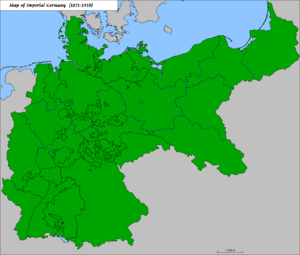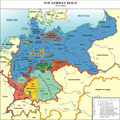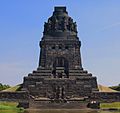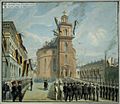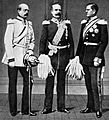Unification of Germany facts for kids
Imagine a time when Germany wasn't one country, but many small states! The Unification of Germany was a big event in the 1800s. Before this, Central Europe had hundreds of tiny states. Some were so small you could walk across them in an hour! Many people living there dreamed of a strong, united German nation.
This dream came true on 18 January 1871. After a war called the Franco-Prussian War, German leaders met in Versailles, France. They gathered in the beautiful Hall of Mirrors. There, they announced the creation of a new German nation. All the independent German states joined together to form the German Empire. Otto von Bismarck, who was the Prime Minister of Prussia, became the first Chancellor of this new empire.
The idea of a united Germany started much earlier, during the Napoleonic Wars. In 1813, many German states teamed up with Russia, Sweden, and Austria. They fought against Napoleon's army at the Battle of Leipzig, also known as the Battle of Nations. Later, in 1815, the Congress of Vienna officially ended these wars. At that time, Austria was the strongest German state. But Prussia soon became its main rival for power.
Uniting all these states was not easy. Not everyone agreed on the idea. Some worried that Austria and Prussia would become too powerful. There were also tricky questions about taxes. Who would collect them? How much would people have to pay? These were big challenges to overcome.
What Was Germany Like Before Unification?
Before Germany became one country, there were hundreds of small areas. These included duchies (lands ruled by a duke) and kingdoms. Many of them were part of the Holy Roman Empire. This empire began in 800 AD when Pope Leo III crowned Charlemagne, a Frankish king, as its emperor.
By the 1700s, the rulers of these hundreds of parts of the Holy Roman Empire were mostly independent. They rarely listened to the Emperor. They often fought against each other or even against the Emperor himself. During the Napoleonic Wars, the Holy Roman Empire was ended. Napoleon created a new group of states called the Confederation of the Rhine. But Napoleon was soon defeated. The Congress of Vienna then reorganized the German states into a new group called the German Confederation. Later, Bismarck created the North German Confederation, which then became the German Empire.
Images for kids
-
The German Empire from 1871–1918
-
Map of the Holy Roman Empire in 1789.
-
Important leaders: Bismarck (left), Albrecht von Roon (center), and Helmuth von Moltke (right).
-
18 January 1871: The proclamation of the German Empire in the Hall of Mirrors.
-
Monument to Kaiser Wilhelm, at Koblenz.
See Also
 In Spanish: Unificación alemana para niños
In Spanish: Unificación alemana para niños


